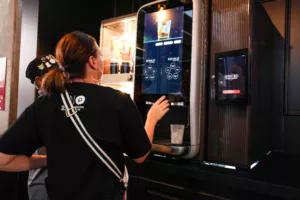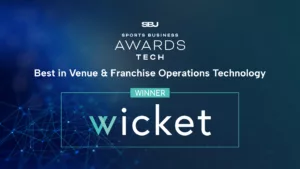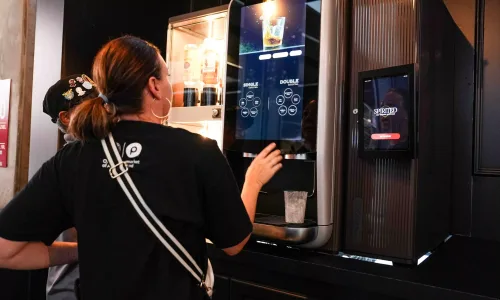There’s no experience like going to a live game produced by a major sports league, and these industry giants pair incredible athletic performance with mind-blowing tech, unbeatable fan interactions, and excellent food and beverages. Of course, it’s no easy task creating that atmosphere—there are innumerable expenses franchises in the NFL, NBA, NHL, MLB, and MLS have to shoulder to stay competitive, and many of them revolve around managing the tens of thousands of people who bought a ticket.
Teams in every sport are constantly looking for ways to reduce lines and maximize revenue, and the Cleveland Browns recently showcased systems leveraging biometric authentication advantages throughout their stadium. Facial authentication software helped the Cleveland Browns to accelerate fan entry by an impressive 400% in their Express Access lanes, and Express Beer kiosks made it quicker and easier than ever for fans to grab a drink and get back to the action.
These innovations delivered impressive returns on the investment, delighting fans and saving the franchise $8000 per Express Access lane alone—not to mention creating unforgettable home-field energy. Results like these are precisely why teams across major sports leagues are using facial authentication across a broad range of use cases, and it’s no surprise that they’re seeing results from the ticket line to the bottom line.
Let’s explore the biometric authentication advantages these systems produce for major leagues and how they’re impacting several key areas in stadiums and arenas.
Facial Ticketing
One of the most exciting applications of facial authentication (FA) at major league events is facial ticketing. Fans who choose to use this opt-in/opt-out service simply pre-enroll by creating an account online. When they buy their tickets, they’re linked to their FA profile the same way plane tickets are added to a digital wallet. Upon arrival at the game, fans can use the Express Access lanes equipped with facial authentication systems to validate their tickets just by walking past and looking at the pedestal’s camera. Multiple tickets on the same account can also be verified with one look, allowing groups of family or friends to enter at the same time.
The Cleveland Browns, one of the early adopters of this ticketing system, revealed that facial ticketing helped them clear the gates before kickoff an average of 10 minutes faster than traditional ticketing methods. Facial ticketing also helped them reduce the space needed for ticketing ingress operations by 75% and freed up staff to be redeployed to more critical areas.
Facial Payments
Just like with facial ticketing, fans can also link their payment information to their FA account to take advantage of lightning-fast, secure transactions throughout the stadium or arena. This eliminates the need to fumble for cash or cards when making purchases at concession stands or merchandise vendors. These systems boast 99.7% accuracy and a 0% reported false positive rate, so fans will never find themselves being billed for someone else’s purchases. Plus, with the added capability of age verification, patrons can discreetly confirm their eligibility for beer purchases, ensuring fast and accurate compliance with legal regulations for purchasing alcohol.
Another one of the biometric authentication advantages these systems deliver is the ability to integrate with other solutions like self-service kiosks to further enhance transaction speeds. These investments deliver maximum ROI for existing tech while making it easier than ever for fans to grab a quick bite.
Smooth Stadium Operations and Access
Facial authentication systems can also be used to simplify entry and access for players, staff, and other authorized individuals throughout stadiums and training facilities. They eliminate hassles caused by lost or forgotten IDs and ensure that everyone can quickly and safely reach the areas they need to access.
The New York Mets have already implemented the use of this biometric system for staff entry points at Citi Field. Staff can easily enter and navigate the stadium with a simple facial scan. By enhancing security measures with 2-factor authentication and streamlining operational efficiency, the Mets are providing a safer and more convenient experience for everyone involved in stadium operations.
And the best part is, these use cases rely on the same technology major league sports teams are already using to streamline transactions and ticketing, so it’s simple for teams to implement and requires minimal training. That’s why the top facial authentication solutions can be onboarded and ready to go live in as little as 30 days throughout even the largest venues.
Comfort in Any Weather
While facial authentication isn’t the only biometric system available, its touchless and effortless design makes it ideal for dynamic environments like live sports that fingerprint and iris scanners don’t. Just ask Cleveland Browns fans: the average winter temp at the stadium during the winter hovers around freezing, and January regularly sees over 18 inches of snow.
Facial authentication doesn’t require anyone to remove their gloves to touch a fingerprint scanner, and they won’t have to wait around shivering while everyone gets their eyes lined up with finicky iris scanners. In fact, they’ll never be more thankful to have a speedy trip inside with a quick glance at a facial authentication system.
Convenience and Confidence for Your Fans
While facial authentication offers a convenient and efficient way to navigate stadiums, some fans might need more support and information to choose to register with their biometric data. Fortunately, FA technology prioritizes data security and privacy. Here are some of the top biometric authentication advantages that let your fans know you’re always putting them first.
- Optional Participation: The program is entirely voluntary. Fans who prefer traditional ticketing methods can still use scannable tickets.
- Data De-identification: The kiosks don’t store pictures of fans’ faces. Instead, they create codes from the selfies fans take, which are then matched with their tickets. When the stadium cameras check in fans, they only match your face with the code. So, even if someone steals or hacks into the kiosks, they can’t get the fans’ pictures because only the code is stored on the devices.
- Limited Use of Data: The facial authentication program is solely used for stadium operations. Moreover, the captured data is not sold to any third-party company.
The Future of Biometric Authentication in Major Leagues
The significant advantages in speed, convenience, and cost savings are likely to propel facial authentication further into the mainstream of major league games. As technology advances, FA systems will likely become even more sophisticated. That means biometric authentication advantages will continue to grow for teams who invest early and maximize the footprint of this flexible and revenue-boosting software.
To find out more about how these systems can benefit any major sports league—and why it’s driving fans wild—check out all the ways these platforms can be leveraged throughout stadiums and arenas today.







